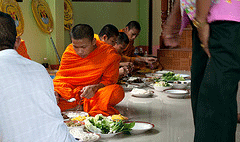 People who adopted a vegetarian diet for just five days show reduced levels of toxic chemicals in their bodies. In particular, levels of hormone disrupting chemicals and antibiotics used in livestock were lower after the five-day vegetarian program.
People who adopted a vegetarian diet for just five days show reduced levels of toxic chemicals in their bodies. In particular, levels of hormone disrupting chemicals and antibiotics used in livestock were lower after the five-day vegetarian program.
The pilot study suggests that people may be able reduce their exposure to potentially dangerous chemicals through dietary choices, such as limiting consumption of animal products like meats and dairy.
What did they do ?
Twenty-five participants lived in a Buddhist temple and adopted the monks’ lifestyle – including their traditional vegetarian diet – for five days.
At the beginning of their “Temple Stay,” participants completed a questionnaire about what they had eaten in the previous 48 hours. They gave a urine sample to provide information on level of exposure to antibiotics and phthalates before the program began.
None of the participants had taken any antibiotics or pharmaceutical drugs in the previous month. After five days of following a traditional Buddhist monk lifestyle and diet, participants again gave a urine sample so that levels of chemicals in their bodies after the program could be assessed.
Because it is difficult to measure levels of phthalates directly, researchers typically measure levels of their breakdown products in the urine samples.
In this case, the scientists looked at levels of six different phthalate breakdown products as well as concentrations of three commonly used antibiotics and two of their breakdown products.
The researchers compared levels of phthalates and antibiotics in the body before and after the program.
They also examined how the foods eaten in the days prior to the start of the Temple Stay related to the before levels of chemicals in their urine.
What did they find ?
Participants varied greatly as to which antibiotics were detected in their bodies at the start of the study. By the end of the study, in many cases, participants’ antibiotic concentrations were too low to be accurately measured.
For those samples that could be measured, moreover, both urinary levels of the antibiotics and the estimated daily intake of antibiotics had decreased after the Temple Stay.
Every participant had measurable levels of all six phthalate breakdown products at both the beginning and end of the study. However, after the five-day program, levels of all but one had dropped significantly, as had the estimated daily intake of phthalates.
The researchers also found that the foods participants ate in the 48 hours before starting the program were related to the concentrations of antibiotics and phthalates in their bodies.
Beef, pork and dairy were associated with starting urinary levels of the various antibiotics, suggesting that those foods may be major inadvertent routes of exposure to the pharmaceuticals.
Similarly, levels of one particular phthalate breakdown product were related to number of servings of dairy products consumed in the previous 48 hours.
What does it mean ?
The dramatic reductions in antibiotic and phthalate levels resulting from the five-day Temple Stay program of lifestyle and dietary change suggest that the body’s chemical burden can be reduced even within a very short time frame.
At the same time, phthalates remained in the urine of all 25 participants, albeit at lesser levels, even after the five-day program.
The finding reinforces current thinking that diet is an important source of phthalate exposure but not the only one. Other sources of exposure include personal care products, home furnishings and dust.
Antibiotic levels showed a more dramatic drop, suggesting that food is, in fact, the major route of exposure.
This study is among the first to look at how diet affects phthalate and antibiotic levels in the body and shows that reduced consumption of animal products may be important. However, it also leaves many questions unanswered.
The specific type of vegetarian diet and the Buddhist monk lifestyle adopted by participants in the Temple Stay are not described in great detail by the study’s authors.
Vegetarian diets can vary considerably and because no additional information on the Temple Stay diet was provided, it is difficult to make more specific dietary recommendations on how the public can reduce chemical exposures.
For instance, the authors don’t report on whether the Temple Stay diet was free of dairy products as well as meats. Whether the foods consumed by participants were mostly fresh and unprocessed is also an important question.
When it comes to chemical exposures in the diet, the specific foods consumed may prove to be less important than how those foods are processed, packaged and prepared.
Further research is needed to examine those issues, particularly in isolation from other lifestyle changes.
Aside from the dietary changes during the Temple Stay, the adoption of a traditional lifestyle during the five-day period may have also contributed to reduced chemical exposures in the participants, particularly phthalate levels.
Although lifestyle factors likely played a lesser role compared to food, without knowing more about the participants’ living conditions and surroundings during the program, it is impossible to rule out the importance of phthalate exposure through the environment.
Nevertheless, this initial finding provides strong evidence that dietary and other lifestyle changes can reduce exposure to a range of potentially harmful chemicals even on a very short time scale.
Source : http://www.environmentalhealthnews.org




